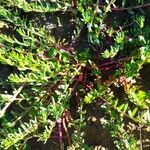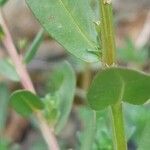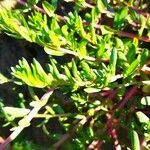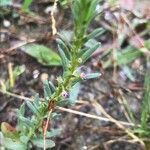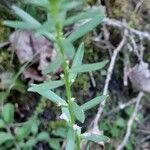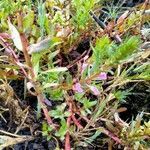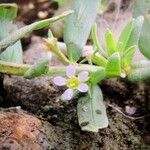Herb, annual, decumbent or ascending, glabrous. Stems ribbed, to 60 cm long. Leaves mostly alternate, sessile or subsessile, linear to oblong or oblong-lanceolate, to 4 cm long, acute to obtuse, the base obtuse. Flowers solitary in upper leaf axils, subsessile; pedicel to 1 mm long. Hypanthium obconical, 3–6 mm deep, c. 1 mm wide; appendages 4–6, narrowly triangular, c. 1–1.5 mm long. Sepals 4–6, shallowly triangular with apiculum of hairs, c. 0.5–1 mm long. Petals 4–6, spreading, ovate, 1-4 mm long, pink, blue or purple. Stamens usually 4–6 or rarely 8–12 and dimorphic, included to scarcely exserted. Capsule cylindrical, to 5 mm long, c. equal to hypanthium.
Annual or biennial herb, hydrophyte, 0.1-0.3 m high, glabrous; stems 4-angled, strongly winged, often branched from base. Leaves alternate, sessile, narrowly oblong, apex broadly acute, base cuneate to rounded. Inflorescence usually of solitary, axillary, nearly sessile flowers. Flowers homostylous, with 2 bracteoles. Calyx subcylindrical, 6-lobed, with conspicuous calyx appendages. Petals 2-6 mm long, pink or light purple. Stamens 12. Ovary subsessile, oblong, incompletely 2-locular; style included; stigma capitate. Capsule usually septicidally dehiscent with 2 valves. Seeds few to many.
Pale green annual 1–6 dm; stem 4-angled; lvs linear to narrowly oblong, mostly alternate, 1–2 cm, a few often elliptic and to 6 mm wide; fls pale purple to white, sessile, solitary or paired; hypanthium half as long as the subtending lf; stamens and pet 4–6, the pet cuneate, 2–3 mm; 2n=20. Mostly in wet soil, especially around salt-marshes; Me. to N.J. and e. Pa.; s. O.; also on the Pacific coast, in S. Amer., and widely distributed in the Old World. June–Sept.
Subwoody, sometimes decumbent herb, up to 500 mm tall. Stems 4-angled and strongly winged. Leaves alternate, sessile, narrowly oblong to oblong-elliptic. Flowers solitary, axillary, nearly sessile; calyx 6-lobed. Flowers pink or light purple, sometimes pale yellow at base.
